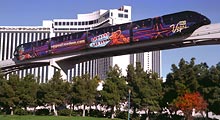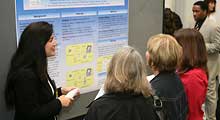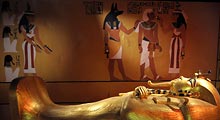Thursday, December 9
8:30 am – 9:10 am
Feet on the Floor—Mobilizing Patients, an Interdisciplinary Approach
Janet Fantazia RRT BSHS AE-C, Modesto CA
What can we do as RTs to help our patients with mobility? We have heard about mobility with ventilator patients in the ICU. This presentation is to encourage mobility in all areas of the hospital.
8:30 am – 9:10 am
Cultural Competency
Patient-centered Care and World View Differences—It’s Not All About Me
Robin Kidder RRT AE-C, St Louis MO
How patients view health care providers and how health care providers view patients are directly proportional. We used to think of cultural competency as based on age, sex, disability, race, ethnicity, religion, and sexual orientation. Hear from a therapist’s perspective their experience with cultural diversity when providing care to patients and interacting with peers and members of the health care team.

Holiday Decorations at Bellagio
8:30 am – 9:25 am
My Patient’s Airways Are Plugged: What Should I Do?
Poor airway clearance for a variety of reasons is a common occurrence in the neonatal and pediatric setting. This old problem continues to generate great controversy. This session will debate two common approaches: drug therapy and secretion clearance devices. Which is more effective? Which is more resource effective? Does it even matter? Two experts in the field will debate the options. Come see what they have to say and offer your opinions.
8:30 am – 8:55 am
Drug Therapy Is As Effective As Secretion Clearance Devices
Bruce K Rubin MD MEngr MBA FAARC, Richmond VA
Pharmacology in airway clearance has grown over the past 10 years. With new generation mucolytic being phased in and old being phased out, which one is best for my patient? Hypertonic saline is now being used at an increasing rate for a variety of effectiveness. Should this be the new airway clearance drug of choice? I have parents ask me about expectorants, what am I supposed to tell them? Are they helpful? Is drug therapy cheaper and more effective than airway clearance devices and therapist time? Is there data to support the increasing use of medications? This presentation will review the data and rationale behind drug therapy in those patients who require assistance with airway clearance.
9:00 am – 9:25 am
Proper Airway Maintenance and Secretion Clearance Devices Are More Effective Than Mucolytics
Brian K Walsh RRT, Dallas TX
The variety and design of airway clearance devices and therapy has changed dramatically over the past 10 years. Do we really need drug therapy to properly maintain airway clearance, or can we maintain airway function with the use of proper airway clearance techniques? Is there a right time, right place, and right patient for each of the devices? Or are mucolytics actually more cost effective? Are there any data? This presentation will review the data and rationale behind the use of secretion clearance adjuncts or devices.

McCarran International Airport
8:30 am – 9:35 am
Ventilator Graphics: What Can I See, What Can I Do?
8:30 am – 9:00 am
Basic Graphics Interpretation: Easy Steps to Success
John S Emberger RRT, Newark DE
Participants will see live, real-time graphics and learn an easy approach to interpretation of most common issues in the adult ventilator patients. Interventions for the common problems will be displayed and discussed.
9:05 am – 9:35 am
Advanced Graphics Cases
John S Emberger RRT
Participants will see live, real-time graphics of a wide variety of particularly unusual cases. Interventions and progression of these complicated cases will be discussed.
8:30 am – 10:15 am
A Rational Approach to Acquiring Capital Equipment and Supplies
8:30 am – 9:20 am
Equipment Evaluation in RT: A Successful Systematic Approach
Joseph Dwan MS RRT, Clackamas OR
The presenter will guide the attendees through the iterative process that he has hard-wired in his organization that is based on defined criteria that has allowed his organization to make sound decisions on capital equipment selection.
9:25 am – 10:15 am
A Rational Approach to Purchasing RT Supplies for Quality and Cost Savings
Joseph Dwan MS RRT
Using criteria-based evaluation and Group Purchasing Standards (GPO), the presenter will review how he has succeeded in reducing costs while maintaining quality in the acquisition of RT supplies for his organization.

Fremont East Entertainment District
8:30 am – 10:25 am
Emerging Trends in Long Term Mechanical Ventilation
8:30 am – 9:05 am
Trends in Alternate Site and Home Ventilation: New Challenges for RTs
Gene Gantt RRT, Livingston TN
There are emerging trends in use of NIV in alternate sites. Accordingly, there are changes in patient population and challenges in payer acceptance.
9:10 am – 9:45 am
Conversion from Artificial Airway to Noninvasive Ventilation: Clinical Challenges
Zachary Gantt RRT, Livingston TN
Transition from ETT to volume assisted NIV for long term ventilation may be the new paradigm. Transition and decannulation of tracheostomized patients to NIV presents significant clinical challenges. Case presentations will be used to demonstrate patient pathways.
9:50 am – 10:25 am
LTC—A New Era in Respiratory Education Preparing the New RTs
Christy D Walker RRT, Dalton GA
Importance of clinical education in the LTC setting among the growing population of patients needing respiratory care outside of acute care facility it a increased need. The levels of expectation, comfort, clinical competency and understanding of the care of the patient in the LTC setting prior to, and following the clinical experience may be lacking in the current system. This presentation will examine the impact of LTC clinical education on students as part of the advance practitioner respiratory therapy program.

Gondola Rides at The Venetian
8:30 am – 11:05 pm
Putting Best Evidence into Practice for Optimum Patient Benefit
8:30 am – 9:05 am
What Is Knowledge Translation, and Why Should I Care?
David J Pierson MD FAARC, Seattle WA
High-quality evidence and clinical practice guidelines do not guarantee improved patient care. This presentation defines the important and growing field of knowledge translation and identifies the barriers that prevent its effective implementation. It provides concrete examples of these barriers from the field of respiratory care and describes approaches for overcoming them for the benefit of patients, institutions, and the whole health care system.
9:10 am – 9:45 am
Applying Best Evidence in the Use of Sedation in the Mechanically Ventilated Patient
Charles G Durbin Jr. MD FAARC, Charlottesville VA
Important patient outcomes are affected by the use of sedation by clinicians managing mechanically ventilated patients. This presentation reviews the currently available evidence on this topic and discusses how it may be applied practically at the bedside.
9:50 am – 10:25 am
Mechanical Ventilation and the “N of 1” Patient Care Construct
David M Wheeler RRT-NPS, Cleveland OH
Evidence-based medicine is the conscientious, explicit, and judicious use of current best evidence applied to the decision-making process concerning the care of individual patients. The n-of-1 practice construct is a means of formulating mechanical ventilation strategies with and for patients in an individualized fashion, incorporating continuous monitoring of their response. This presentation will elaborate on these definitions and illustrate how best evidence can be used to improve the care of individual patients.
10:30 am – 11:05 am
Setting the Ventilator for Maximum Patient Comfort
Richard H Kallet MS RRT FAARC, San Francisco CA
The patient’s experience of mechanical ventilation during acute illness can vary dramatically depending on how the clinician sets the ventilator, apart from such considerations as tidal volume, pressure limits, and mode. This presentation addresses patient-ventilator synchrony in this context, summarizing the available evidence and discussing how it can best be applied at the bedside.

The Neon Museum
9:00 am – 11:35 am
Journal Symposium: What’s Respiratory Care Up to These Days?
9:00 am – 9:35 am
Journal Conference Summary: Neonatal and Pediatric Respiratory Care: What Does the Future Hold?
Ira M Cheifetz MD FAARC, Durham NC
This presentation will summarize the Respiratory Care Journal Conference on Neonatal/Pediatric Respiratory Care.
9:40 am – 10:15 am
Journal Conference Summary: Patient-Ventilatory Interactions
David J Pierson MD, Seattle WA
This presentation will summarize the Respiratory Care Journal Conference on Patient-Ventilator Interactions.
10:20 am – 10:55 am
The Top 5 Original Research Papers Published in RESPIRATORY CARE in 2010
Dean R Hess PhD RRT FAARC, Boston MA
This presentation will identify and review the 5 best original research papers published in the Journal in 2010.
11:00 am – 11:35 am
The Top 5 Case Reports Published in RESPIRATORY CARE in 2010
David J Pierson MD, Seattle WA
This presentation will indentify and review the 5 best case reports published in the Journal in 2010.

World-Class Golf
9:15 am – 10:55 am
Gaps in COPD Care: What They Are and What We Need to Do
9:15 am – 9:45 am
Gaps in Making the Diagnosis
Joshua Benditt MD, Seattle WA
The presenter will describe the obstacles in having COPD properly diagnosed in a timely manner and discuss the impact of early detection in reducing the rate of further deterioration in lung function.
9:50 am – 10:20 am
Gaps in the Management of Exacerbations During Hospitalization
Naresh A Dewan MD, Omaha NE
This presentation will discuss the variances in how COPD exacerbations are being managed during a hospitalization and will review the evidence-based guidelines for the optimal management of an exacerbation.
10:25 am – 10:55 am
Gaps in Discharge Planning
Debra M Koehl MS RRT-NPS, Indianapolis IN
The presenter will discuss the consequences of poorly coordinated discharge planning of a COPD patient following admission for an exacerbation and will describe the potential advantages of having RTs more involved in the discharge planning process for these patients.
9:30 am – 10:25 am
Inhaled Medical Gases: More Than Oxygen
Unlike the early days of the inhalational therapists, respiratory therapists administer many medical gases beyond oxygen. This session will review the application of inhaled gases in the health care setting.
9:30 am – 9:55 am
Heliox and Inhaled Anesthetics: More Than Just Beta-Agonists for the Asthmatic
Melissa K Brown RRT, San Diego CA
Heliox and inhaled anesthetics play a valuable role in the management of the asthmatic. The medical literature along with the technical aspects of gas delivery will be reviewed. Care of the patient with status asthmatics is much more than oxygen, steroids, and beta-agonists.
10:00 am – 10:25 am
What Other Therapeutic Gases Can Patients Inhale?
Jenni Raake RRT MBA, Cincinnati OH
Have you ever considered administering carbon dioxide, carbon monoxide, or nitrogen to your patients? Why would you consider these approaches? This presentation will review the clinical applications of the more “unusual” inhaled medical gases.

Open Forum
9:30 am – 11:25 am
OPEN FORUMs #14—Education, Part 2
OPEN FORUMs #15—Monitoring/Equipment, Part 2
Clinicians present the results of their scientific studies. Abstracts with a similar focus are clustered into a symposium to encourage discussions and interactions among investigators and observers; posters expand the information presented. See abstract titles and authors.
9:45 am – 10:35 am
Blood Gas Laboratory: POC Certificate Program
Bruce Toben RRT-NPS CPFT, Piscataway NJ
The American Association for Clinical Chemistry (AACC) is developing a program to educate participants on best practice standards as they relate to blood gas laboratory operations. This Web-based modular program will include sessions on regulatory compliance, quality assurance systems, device connectivity, and other topics pertaining to laboratory diagnostic testing. Admission criteria for the program and highlights of each module will also be discussed.
10:20 am – 11:10 am
Managing the Represented Workforce
Richard M Ford RRT FAARC, San Diego CA
Unions represent health care workers in a variety of capacities. While some managers view organized labor as a burden, others build great teams. Consideration in managing a represented workforce will be discussed and programs described that provides staff with a voice in department level decision making.
10:30 am – 11:55 am
Respiratory Care of the Child with Neurodisability
10:30 am – 10:55 am
Pulmonary Complications in the Child with Neurodisability
Robert Warren MD, Little Rock AR
This presentation will describe the progression of chronic lung disease in the child with neurodisability. Specific topics will include the challenge of managing airway secretions as well as invasive and non-invasive ventilatory strategies.
11:00 am – 11:25 am
Living Longer, Living at Home
Denise Willis RRT-NPS, Little Rock AR
This presentation will describe the therapist’s role, both inpatient and outpatient, in caring for technology-dependent children. Issues and challenges include equipment hurdles, the home environment, family involvement, transitioning to adult hospital as patient ages, and more. Emphasis will be placed on quality of life.
11:30 am – 11:55 am
Acceptance, Avoidance, and Advocacy—A Parent’s Perspective
Amy Wilson EMT, Benton AR
As a parent of a respiratory-technology dependent child, this session will demonstrate what families want therapists to know about caring for trach/ventilator-dependent children. The family’s perspective, challenges, coping mechanisms, and emotions will be shared. You may cry and laugh, but you will not forget this presentation.

Vegas Showgirls
10:30 am – 12:00 pm
Keep Them Awake: Developing Powerful and Productive In-Service Education Programs
Jody Lester MA RRT, Nampa ID and Bill Galvin MSEd RRT CPFT AE-C FAARC, Gwynedd Valley PA
Are you charged with developing clinician or patient in-services? Come learn the steps that will ensure your success. Topics will include learning objectives, PowerPoint development, and outcome assessment.
11:05 am – 11:50 am
Sleep Section Membership Meeting
Tony Stigall MBA RRT RPSGT/Presiding
Section members meet to determine their needs and priorities, as well as how to use the AARC resources to accomplish them. All Congress attendees, including section non-members are invited to attend and to participate.

Las Vegas Monorail
11:15 am – 12:00 noon
Surface & Air Transport Section Membership Meeting
Steven E Sittig RRT-NPS C-NPT FAARC/Presiding
Section members meet to determine their needs and priorities, as well as how to use the AARC resources to accomplish them. All Congress attendees, including section non-members are invited to attend and to participate.
11:15 am – 12:05 pm
A Common Sense Guide to Patient Safety for the RT
Thomas R Lamphere RRT, Sellersville PA
Patient safety is a primary concern for all health care workers including the RT. Groups such as The Joint Commission and state/federal agencies have been formed to create and enforce numerous rules and regulations aimed at keeping patients safe.
11:20 am – 12:00 noon
Implementation of A Respiratory Care Services Inpatient Satisfaction Program
Dottie Biggar RN ANP-BC, St Louis MO
The Joint Commission requires hospitals to measure patient satisfaction. However, a “real time” system that would provide feedback that allows for immediate intervention is needed and will be reviewed in this session. In addition to a review of the tools and process that were involved in implementing this program, the presenter will provide tips to prevent potential pitfalls encountered, including surveyor bias.

Spago at Caesars Palace
1:00 pm – 1:40 pm
Challenges in Pediatric Non-invasive Ventilation
Jenni Raake MBA RRT, Cincinnati OH
Pediatric non-invasive ventilation is a challenge — both in terms of devices and interfaces. This presentation will explore these challenges and share thoughts for solutions. Interface issues, patient comfort, and evaluation of clinical efficacy will be discussed.
1:00 pm – 1:40 pm
Interdisciplinary Clinical Practice
Ellen Perry RRT, Chandler AZ
This presentation will define RT scope of practice, explain the implications of interdisciplinary care, and describe how electronic medical records impact RT care.
1:00 pm – 1:45 pm
Strategies for Maintaining & Increasing Patient Sleep Volume in Tough Times
John Sabo MS RRT RN, Houston TX
The speaker will share successful marketing strategies for maintaining volumes in these tough times. Specific discussion items include development of a branding strategy, Continuous Patient Aftercare Program (CPAP), development of alternate referral sources and adoption of more entrepreneurial marketing efforts.
1:00 pm – 1:50 pm
RT as Inventor: How to Invent, Analyze, Develop, and Protect New Product Ideas
Daniel J Grady MEd RRT FAARC, Asheville NC
Respiratory therapists are natural inventors because of their expertise in clinical problem solving and adapting technology to clinical needs. This presentation will identify two techniques for inventing new technology and cite 3 criteria which may be used to analyze marketability of new technology. Resources that may be used for research and development of inventions will also be discussed.
1:00 pm – 1:50 pm
Understanding Change Management
Cheryl Hoerr MBA RRT CPFT FAARC, Rolla MO
Some people dread change while others welcome it, especially if they’re the ones pushing for the changes. Change is inevitable, and managers must be able to teach their staff how to embrace change by understanding the reactions to change and using the understanding to deal with the challenge of change.

Picasso’s at Bellagio
1:00 pm – 2:40 pm
Inhalation Injuries and Burns: What You Need to Know
1:00 pm – 1:30 pm
Anatomy of Inhalation Injury
Shawn Fagan MD, Boston MA
Inhalation injury can be a life-threatening crisis. Careful assessment and management of these patients must take place in a timely manner. This presentation will describe the physiologic effects of inhalation injury.
1:35 pm – 2:05 pm
Inhalation Injuries—A Great Challenge for Respiratory Therapists
Kathy Short RRT RN, Chapel Hill NC
This presentation will describe the challenges respiratory therapists face when caring for patients with inhalation injuries and burns. It will explain how an interdisciplinary approach to care is vital to the survival of patients with inhalation injuries.
2:10 pm – 2:40 pm
Blood, Sweat and Tears: Long-term Outcomes of Burn Patients
Shawn Fagan MD
Patients with thermal injuries require intensive treatment for a long period of time. After all of the resources needed to care for these patients, what are the long-term outcomes and quality of life? This presentation will show case studies illustrating the ongoing effects of burn injuries.

Open Forum
1:00 pm – 2:55 pm
OPEN FORUMs #16—Ventilation/Ventilators, Part 3
OPEN FORUMs #17—Neonatal/Pediatrics, Part 2
Clinicians present the results of their scientific studies. Abstracts with a similar focus are clustered into a symposium to encourage discussions and interactions among investigators and observers; posters expand the information presented. See abstract titles and authors.
1:00 pm – 3:15 pm
Evidence and the Best Practice of Respiratory Care
1:00 pm – 1:30 pm
Clinical Trials and Their Impact on the Practice of Respiratory Care
Thomas Wing MHS RRT, Boise ID
Specific examples will be used to demonstrate the processes by which clinical trial outcomes serve as a driving force behind the determination of best practice. Additionally, the presenter will discuss the roles and responsibilities of RTs in this process.
1:35 pm – 2:05 pm
Lavage with Suction—Convincing Verdict or Is the Jury Still Out?
Jody Lester RRT, Nampa ID
Lavage prior to tracheal suction has been largely discontinued following analysis of the evidence. However, a recent study found lower VAP rates in patients who were lavaged. A discussion of this topic will be used to help illustrate the process for evaluating conflicting research findings.
2:10 pm – 2:40 pm
Therapeutic Hypothermia Following Asphyxia—How Strong Is the Current Evidence?
Thomas Wing MHS RRT
The presenter will analyze and discuss the study outcomes for trials of adult, pediatric and newborn populations who were treated with therapeutic hypothermia after asphyxia. A specific focus will be to determine whether the evidence supports continued practice.
2:45 pm – 3:15 pm
Fetal Origin of Adult Disease—How New Concepts May Affect Practice
Jody Lester RRT
Barker’s hypothesis of fetal origin of adult disease (FOAD) will be used as the foundation for discussion of how new concepts may affect practice.

World’s Largest Gift Shop
1:00 pm – 3:50 pm
Pulmonary Rehabilitation 2010 & Beyond: Challenges and Opportunities
1:00 pm – 1:30 pm
NCD, ITP, MAC, etc: Learning and Understanding the Acronyms
Debra Koehl MS RRT-NPS AE-C, Indianapolis IN
The presenter will describe the myriad of abbreviations used to describe the various aspects of pulmonary rehabilitation and the importance of a thorough understanding of their interpretation.
1:35 pm – 2:05 pm
Medical Direction in Pulmonary Rehabilitation
Brian W Carlin MD FAARC, Pittsburgh PA
This presentation will describe the role of the medical director in a pulmonary rehab program and how to comply with CMS requirements.
2:10 pm – 2:40 pm
Documentation Essentials
Gerilynn Connors RRT FAACVPR, Falls Church VA
The presenter will discuss the required documentation for timely reimbursement for pulmonary rehabilitation and provide insight into how audits are conducted and ways to avoid problems.
2:45 pm – 3:15 pm
Staffing Essentials
Trina M Limberg RRT, San Diego CA
The presenter will describe how to plan for proper patient-therapist ratios in a pulmonary rehab program and discuss the use of multi-disciplinary professionals in the most effective manner.
3:20 pm – 3:50 pm
Pulmonary Rehabilitation for the Lung Transplant Patient
Paul F Nuccio MS RRT FAARC, Boston MA
The presenter will discuss the special and unique pulmonary rehabilitation needs of this special patient population.
1:45 pm – 2:25 pm
Coughers, Wheezers, and Noisy Breathers
Robert Warren MD, Little Rock AR
Children often cough and wheeze. What does it mean? Which children require work-up and therapy? This presentation will offer thoughts on the different diagnoses of infants and children who present with wheezing or coughing. Therapeutic considerations will be discussed.

Sahara Casino
1:45 pm – 2:25 pm
Improving Written Communication:
A Review for Busy Health Care Professionals
William A French MA RRT, Kirtland OH
Within the respiratory care community, there are many ways for individuals to share unedited written communication (eg, listservs, AARConnect, etc.). Too often, these communications contain errors in spelling, punctuation, grammar, and rhetoric. These errors detract from the credibility of the communication and make the writer (and, by extension, the profession) appear less professional. This presentation shows examples of such communication (done discreetly), demonstrates how such errors could be corrected and/or avoided, and reviews basic principles of writing in English. Resources for improving writing would also be presented. Effective communication among health care professionals is becoming more important all the time. And yet, communication skills are often under emphasized in school and not reinforced in practice.
1:50 pm – 2:35 pm
The Basic Concepts of LEAN
Darnetta Clinkscale MBA RRT, St. Louis MO
We’ve all seen the typical “flavor of the month” that purports to improve quality and customer satisfaction while cutting costs to the bone. While many of the programs have come and gone and many have not demonstrated any countable savings, the LEAN program is one that has demonstrated reduction of waste while ensuring patient care and safety is maintained and/or improved. This presenter will educate you as to the basic concept and tools that you can implement in your organization.
2:00 pm – 2:50 pm
A New Model for Care—The Acute Pulmonary Unit
John S Sabo MS RRT RN, Houston TX
The presenter will lead the audience through the process whereby his organization created the Acute Pulmonary Unit (APU). Starting with a multidisciplinary team, they developed the strategic objectives and the implementation plan that led to the opening of a unit that met financial and clinical goals.
2:00 pm – 4:10 am
Establishing and Improving an Asthma Self-Management Education (ASME) Program: Applying for the AARC’s ASME Certification
2:00 pm – 2:40 pm
Why Establish an ASME Program
Timothy B Op’t Holt EdD RRT AE-C FAARC, Mobile AL
This presentation will address the rationale for establishing an ASME program. Additionally, it will describe the elements of the ASME program and how an ASME program is organized.
2:45 pm – 3:25 pm
The ASME Instructional Team and Resources
Karen Gregory MS APRN-BC CNS RRT AE-C, Edmond OK
This presentation will identify the instructional team and the physical and fiscal support needs of the program. It will identify the target population and methods for determining individual needs. Additionally, it will address the continuing education requirements.
3:30 pm – 4:10 pm
Action Plans, Patient Outcomes and CQI for an ASME Program
Rhonda Vosmus RRT-NPS AE-C, Portland ME
This presentation will address how to write an asthma action plan, assess outcomes and monitor quality. Additionally, the presentation will discuss who has established a successful ASME program.

Boulevard Shops at Paris
2:30 pm – 3:10 pm
Disease-specific Management Strategies for Mechanically Ventilated Infants
Robert M DiBlasi RRT-NPS, Seattle WA
What are the clinical implications of the latest research? For the last 3 decades, time-cycled, pressure-limited ventilation has been the most common form of respiratory support available for neonates. Research focused on devices and management strategies has identified many new approaches. This presentation will provide the respiratory therapist with clinical insight on disease-specific invasive ventilatory techniques used to support neonates with various forms of lung injury.
2:45 pm – 4:25 pm
Providing Clinical Respiratory Home Care Services in an Austre Financial Environment
2:45 pm – 3:15 pm
An Education Program That Encourages Patient Participation
Robert W McCoy RRT FAARC, Apple Valley MN
The speaker will discuss the importance and necessity of patients assuming greater responsibility in their continuing care at home and will present examples of comprehensive education programs that help patients/caregivers maintain optimal respiratory health in spite of their chronic respiratory disease.
3:20 pm – 3:50 pm
Higher Flow Oxygen Delivery: Available Options
Louis M Kaufman RRT-NPS AE-C FAARC, Olney MD
This presentation will describe the available option for those home care patients requiring higher oxygen doses to maintain effective oxygenation and will discuss strategies to address the limitations of conventional oxygen delivery devices for this unique patient population.
3:55 pm – 4:25 pm
Pulse Dose Delivery Devices: What You Don’t Know Could Hurt Your Patients
Robert W McCoy RRT FAARC
The presenter will review the available performance data for gaseous, liquid and concentrated oxygen pulse dose delivery systems and will describe the unintended consequences of not considering the performance limitations of certain types of pulse dose delivery systems.

Natural History Museum
2:50 pm – 4:25 pm
Coaching, Developing, and Mentoring Your Staff
2:50 pm – 3:10 pm
Promoting Collaboration and Teamwork
Cheryl Hoerr MBA RRT CPFT FAARC, Rolla MO
People want to be appreciated and valued for their contributions. Managers must be able to create a working environment in which people value each other and recognize the importance of each member’s contribution to the team.
3:15 pm – 3:35 pm
Managing Conflict
Karen J Stewart MS RRT FAARC, Charleston WV
Handling conflict in the workplace can be quite difficult. Managers have to deal with forceful egos, with people’s strong beliefs that they are right, and occasionally with childish behavior.
3:40 pm – 4:00 pm
Coaching Others
Cheryl Hoerr MBA RRT CPFT FAARC
High performing organizations have systems in place that encourage each individual to perform to their optimum level. This lecture will share ideas about equipping therapists with the tools and knowledge that they need to develop themselves as well as coaching tips for managers.
4:05 pm – 4:25 pm
Acting Strategically
Karen J Stewart MS RRT FAARC
Strategy keeps you focused so you can decide where to invest critical resources. An understanding of the organization’s broad strategy is essential for ensuring alignment of department goals. This presentation will discuss ways to understand your organization’s strategy, execute against it, and measure your performance.
3:00 pm – 4:05 pm
RTs Take the Lead!
3:00 pm – 3:30 pm
Just Add RTs and Mix!
Mary K Hart RRT AE-C, Dallas TX
All that’s missing from the Peak Performance USA program is the RT. This program is up to date, comprehensive, and Web-based to make it easy to access and utilize. The presenter will guide the audience through the use of this valuable tool that will not only provide great care, but increase the visibility and value of the RT.
3:35 pm – 4:05 pm
RTs Lead the Way in Quality Improvement
Mary K Hart RRT AE-C
This presentation will demonstrate how one hospital respiratory therapist led the way in providing asthma management in the ED through a new and innovative process that improved care, reduced cost, and positioned the RT, among others, as valued health care professionals.
3:20 pm – 4:00 pm
Back to Basics: How Oxygen and Carbon Dioxide Are Transported in the Blood
Andrew M Luks MD, Seattle WA
An understanding of how oxygen gets into the blood, how it is stored and transported once it is there, and how carbon dioxide is carried from the tissues to the lungs for elimination, is fundamental to the practice of respiratory care. This lecture provides a concise refresher course on this bread-and-butter but somewhat complicated topic.
